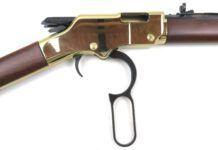Henry Mini Bolt .22LR

The .22 rimfire rifle has started the shooting careers of many serious gun owners, who as kids went plinking at the range with dad, or shot cans off fence posts, or took small game. Most shooters who had a .22 as children didn’t know the triggers were abysmal, the wood plain, the sights clumsy. Nor did we care.
Thankfully, many aspects of .22LR rifle design have improved over the years, not the least of which are polymer stocks and stainless barrels. Still, the shooter who is looking for a rifle for his child or grandchild today wants the same things in a gun he got 30 years (or more) ago: dependable, safe operation, ease of use, kid-sized dimensions, and an affordable price.
We recently tested four bolt actions that meet these and other criteria. Though they are marketed for children, a couple of our test products have enough utility to serve as camp guns, ranch-pickup plinkers, or inexpensive survival guns for backpackers.
Our test guns were the CZ 452 Scout, $242; the Henry Repeating Arms Mini Bolt H005, $200; the Rogue Rifle Company Chipmunk No. 00001, $165; and the Savage Arms Cub Youth, $150. To test the guns, we used adults to collect accuracy data, and adults monitored kids shooting the guns. But we leaned heavily on the kids’ opinions of what they liked (or not) when they were shooting the guns. That was refreshing, because they weren’t at all concerned about brands or money or other adult considerations. They just told us what worked, and what didn’t.
How We Tested
Our evaluations of these guns have stretched over a year. Our test crew included a 7-year-old boy, an 11-year-old girl, a 12-year-old boy, and a 14-year-old teenager, plus a variety of adults. Two of the youth testers have wide shooting experience; one competes in IPSC league matches. The other two testers had competitive air rifle experience.
Our test ammos included Federal .22 LR High Velocity 36-grain copper-plated hollowpoints; Remington .22 LR High Velocity 36-grain lead hollowpoints; and Eley .22 LR Match EPS 40-grain lead solids. We used open sights throughout the test, including shooting accuracy groups at 25 yards.
During plinking sessions, we interviewed the youth shooters and recorded their criticisms without comment. If there were questions about certain issues, we came back for further discussion. We did our best not to color their impressions as they shot the guns.
Nonetheless, we asked about the same areas we grade adult guns on: trigger, balance, fit, and sights.
Here’s what we found:
[PDFCAP(1)]
Introduced in 2001, this single-shot .22 is one of about 12 Henry rimfire rifles, and one of two models with the stainless/synthetic trim and bolt action. The Mini Bolt came with Williams Fire Sights, an illuminated two-green-dot adjustable rear sight and a contrasting red front sight. A beavertail forearm with molded-in checkering offered a comfortable, firm grip. The forend had a 4-inch-long swell that started about 2 inches in front of the trigger guard. We also appreciated the wraparound checkering on the pistol grip.
The one-piece bolt felt smooth in the receiver, and the European-style flattened bolt handle was easy to lock and unlock. The stainless-steel barrel had eight-groove rifling. The manually operated safety tab, located on the left rear end of the receiver, allowed the gun to be carried on Safe when loaded and cocked (which we wouldn’t recommend).
The gun was 30.25 inches long with a 16.25-inch-long barrel. Length of pull measured 11.5 inches, and the stock had a lot of pitch and a fairly high comb. The Mini Bolt weighed 3.25 pounds.
The synthetic stock was a utilitarian black polymer. The gun lacked a rubber buttpad, which isn’t an issue in terms of recoil, but the plastic buttpad slid around on nylon.
The open sights were adjustable for elevation and windage. The gun contained no provision for telescopic sights.
The Williams Fire Sights offered two green illuminated dots in the rear, and one red dot in front. The sights presented a clear, readable picture on target. However, the front sight wasn’t hooded like the CZ, and the front sight got chipped.
The one-piece bolt opened and closed easily; only about a pound of upward force was needed to move the spoon-shaped bolt handle. Locked down, it fit snugly against the stock. To open the action, the shooter must put the two-position safety in the forward Fire position. This exposed a red dot.
To cock the firing pin, the shooter pulled back on the cocking knob. Younger children could pull back the knob without losing control of the muzzle. It took 9.5 pounds of force to pull the knob back.
Problems: When the bolt was pushed forward onto an empty chamber and the safety was set on Fire, the hammer fell if we opened the bolt. This worried us. To see if the bolt hit the cartridge rim, we inserted a “dummy” round in the chamber and pushed the bolt down, with the safety forward and the cocking hammer pulled back. When we then opened the bolt, the Henry’s firing pin had not hit the rim.
Elsewhere, the bottom of the action was not ramped, so the shooter had to insert a round directly into the chamber. We understand there might be a valid safety argument for this setup, but it still made the gun more difficult to load. Also, we noticed the rebated area around the chamber attracted dirt, oil, belly-button lint and just about everything else. It was difficult to clean.
Also, all the steps needed to put the gun into action required the safety to be in the Fire position, because Safe locks the action. We had some qualms about that, and the trigger, too.
Normally, we would applaud a 1.5-pound trigger letoff. But it seems too light for a youth gun. There was a fair amount of creep before letoff, almost like a first stage. The sear didn’t drop cleanly, but we’ve tested a lot of adult centerfire rifles with much worse triggers.
[PDFCAP(2)]
At the range, we got surprising accuracy out of the gun. Shooting at 25 yards, we got 0.5-inch groups using the Remington and Eley ammos.
In terms of user friendliness, our youth testers uniformly liked the Mini Bolt. They all remarked on its light weight and small dimensions. One said it looked like a toy gun (which might be another drawback). Small hands could fit around the pistol grip easily, but when we sprayed the grip with water, it did get slick.
Adults, too, liked the gun. It was possible to shoot it fairly comfortably if the adult or our teen shooter rested both elbows on the torso, and shot out the front of the position, with the gun almost on the chest muscle. From these testers the light trigger drew hurrahs.
The inletting between the barrel/receiver and polymer stock was tight, and so was all the visible workmanship, even the fitting of the hard synthetic buttplate and the pistol grip cap. The metal finish was an overall matte stainless.
[PDFCAP(3)]
This single-shot .22 is one of nine Savage single-shot rimfire rifles, and it is substantially shorter and smaller than the other Savages. Two Stevens lever models weigh about a pound more, and are 3 inches longer. The next smallest bolt gun is the Mark 1-G, which is 6 inches longer and 2 pounds heavier.
The Cub came with a bead post front sight and rear peep sight. The thin hardwood forearm lacked checkering, as did the pistol grip. The bolt felt snug in the receiver, and the round bolt handle was easy to grasp. The action required somewhat more force to unlock than the Mini Bolt — about 2 pounds. The blued-steel barrel had 1-in-16 rifling, and the barrel was free-floated. The safety button was located on the right side of the receiver. The action would work with the gun on Safe. The trigger shoe looked to be stainless steel, as best we could determine. It had a smooth face and a rearward slope to it. When pulled, it came close to the plastic trigger guard (which broke during testing), and the bottom of the trigger shoe would pinch the shooter’s finger.
The gun was 33 inches long with a 16.125-inch-long barrel. Length of pull measured 11.5 inches, and the stock had much less pitch than the Mini Bolt and offered no raised area for the cheek. The Cub weighed 3.75 pounds.
The dark-stained hardwood stock was plain and slick, and it, too, had a plastic rather than a rubber buttpad. The open sights were adjustable for elevation and windage, but they offered a much sloppier aiming area than the Williams sights did, we thought. The post floated in the rear peep sight, so it was easy to get aiming errors. The dovetailed receiver would allow optics to be placed on the gun.
Overall operation was uneventful. Everything on the gun worked as expected. The safety came on and off crisply; the bolt ejected empties well, and because the action had a ramp, it was possible to lay a round in the receiver and close the bolt on it. Also, this gun did not have a cocking knob, so it was faster to cycle and fire.
As we noted before, the trigger would pinch small fingers. And though we know it sounds contradictory to what we said about the Mini Bolt, the Cub’s heavier trigger (5.5 pounds) was too heavy and indistinct, we thought. Nonetheless, we got decent accuracy with the gun, shooting 0.5-inch groups using the Eley ammo.
[PDFCAP(4)]
This single-shot .22 is one of Rogue’s 11 Chipmunk single-shot .22LR rifles, which are differentiated by their stocks and barrel weights. There are five light-barrel models with standard walnut, deluxe checkered walnut, and laminate stocks, plus the same offerings in bull-barrel models. One model has a synthetic stock. Weights range from a scant 2.5 pounds (our test gun’s weight) up to 3.5 pounds for the bull-barrel models.
The Chipmunk came with a blade front sight and rear peep sight. There was no checkering on the walnut forearm or pistol grip. The stock had an oil finish that looked nice, but it didn’t protect the soft wood at all. The gun constantly picked up dings and blemishes. The buttstock featured a Monte Carlo comb and black-plastic buttplate.
This was the most diminutive gun the group, not only in standard dimensions, but almost everywhere. The trigger guard would barely accept an adult male finger; the bolt head was about half the size of the Savage’s knob.
The bolt moved easily in the receiver, and it required only a pound of force to unlock. The blued-steel barrel had 1-in-16 rifling, and the barrel and receiver were tightly fitted to the stock. There was no safety. The pull weight (12 pounds) to cock the bolt was too heavy for our 7-year-old to manage.
The gun was 30 inches long with a 16-inch barrel. Length of pull measured 11.5 inches, and the stock had about the same pitch as the Savage. The dark walnut stock had surprisingly good grain in it, and it wasn’t as slick as the Savage or Henry guns when wet, we thought. The aperture sights suffered from the same aiming errors as the Savage, and this gun was not dovetailed for rings.
The gun worked as expected in loading, firing, and ejection. It did not have a ramp, so the shooter had to insert each round into the chamber. The Chipmunk’s trigger asked for the right amount of pull weight (3.5 pounds), but it was mushy and didn’t have a clear release point, we thought. Also, there was a lot of side-to-side play in the housing. Despite that, we shot 0.6-inch groups using Eley ammo.
[PDFCAP(5)]
The Scout is one of eight 452-model .22LRs made by Ceska Zbrojovka Uhersky Brod. The American and Varmint 452s are also chambered in .22 WMR, .17 HMR, and .17 HMR2. The Lux also comes in .22 WMR, and the FS also comes in .22 WMR and .17 HMR. The Style and the Sihouette .22LR models come in stainless/synthetic combinations only.
The Scout is a magazine-fed action with a walnut stock. The CZ 452 actions are manufactured from steel billets, and the barrels are hammer forged. The trigger is adjustable for weight, and the safety is located above the rear of the bolt and provides a positive firing-pin block. We got a blind magazine for our gun that effectively installed a ramp for single-shot use, but five- and 10-round magazines are available.
The CZ 452 came with a hooded blade front sight and rear notch sight. There was no checkering on the walnut forearm or pistol grip. The stock had a matte urethane finish that filled the wood pores completely. The buttstock incorporated a straight cheekpiece and black-plastic buttplate.
This was the heaviest gun in the group, a function of it having both a thicker walnut forearm and pistol grip and a more substantial steel receiver. The steel trigger guard was roomy enough for adult fingers, and the bolt head was standard size.
This gun resolved some of the problems we found in the other models. The hooded front sight offered protection for the tall steel blade. The trigger broke at a crisp 4 pounds and was easily the best in the test. There was no side-to-side movement of the trigger shoe like we saw on the others. The ramp allowed easy cartridge feeding, and having a magazine-feed option means the gun could grow with the child. The bolt had a big-gun feel compared to the others, requiring only 2 pounds of lift to unlock. The blued-steel barrel was flawlessly finished and tightly fitted to the stock, but it wasn’t free-floated like the Savage. The gun was 32.8 inches long with a 16.2-inch barrel. Length of pull measured 12 inches, and the stock a lot of pitch (the buttstock fell away from the boreline) and seemed to have a mild cast on bend, which allowed the sights to come to the eye better. This receiver was dovetailed to accept scope rings. We shot 0.5-inch groups using Eley ammo.
However, the sight wasn’t nearly as easy to see as the Mini Bolt’s illuminated model. The bolt-mounted safety locked the action closed, but it was very stiff to put on Safe. The safety tab had to be pushed forward with some force to get the gun on Safe. Pulling the tab backward to Fire was easier. The walnut stock had good grain, but the urethane finish was fairly slippery when wet, in our opinion. Checkering would have helped some, but skateboard tape could be applied to solve the problem inexpensively. This rifle had a slightly longer length of pull than the others, which for our test team wasn’t a problem. For very small or young kids, however, it could be too long.
Gun Tests Recommends
Henry Repeating Arms Mini Bolt H005, $200. Buy It. We believe this gun is well suited for a young shooter, as long as there’s adult supervision at hand. The stainless barrel and polymer stock would be more durable than blued steel and wood stocks of the other rifles in the test, in our view. It is light, and its fiber-optic sights are the easiest to see and use of those tested. The flat bolt handle is easy to grasp and use. The 1.5- to 2.5-pound trigger pull was fairly clean and consistent. The safety was easy to operate, the short length of pull fits kids well, and the rifle was accurate and affordable.
Savage Arms Cub Youth .22LR, $152. Don’t Buy. Our youth testers didn’t dislike the Cub, but they clearly preferred the Mini Bolt. The sights and trigger pinch were cited as the biggest problems.
Rogue Rifle Chipmunk No. 1, $165. Don’t Buy. Our youth testers called the Chipmunk a “kiddie” gun, and we can’t disagree with that evaluation. It is small, and older kids noticed the cramped nature of the controls.
CZ 452 Scout Rifle, $242. Our Pick. Good trigger, well made, shot accurately. Though this gun didn’t do everything we wanted, we think it is good enough to buy for the most important shooter you know – your kid.





























